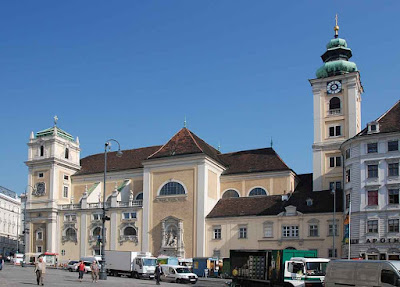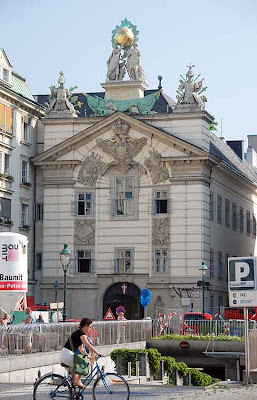 Hapsburg Empire, once second in size only to the Russian Empire in the whole of Europe, Austria's missteps and the ensuing political realities have downsized the country into a virtual European backwater. With a population of eight million (about the same as North Carolina), this now landlocked country, slightly larger than the state of Maine, boasts a capital city, Vienna, that is the size of Houston and is home to a quarter of the population. While its former territories currently have a collective population of nearly 80 million, Austria today, is marginalized as the 115th largest country by land area with an economic output
Hapsburg Empire, once second in size only to the Russian Empire in the whole of Europe, Austria's missteps and the ensuing political realities have downsized the country into a virtual European backwater. With a population of eight million (about the same as North Carolina), this now landlocked country, slightly larger than the state of Maine, boasts a capital city, Vienna, that is the size of Houston and is home to a quarter of the population. While its former territories currently have a collective population of nearly 80 million, Austria today, is marginalized as the 115th largest country by land area with an economic output that falls between those of Norway and Greece.
that falls between those of Norway and Greece.But, what of Vienna? Nine hundred years in the making, many of them spent as a major player in Europe with lands extending from Spain to Hungary, the capital city was fittingly decked out. There are so many big attractions - museums, parks, palaces, churches, civic buildings, cultural centers, architectural wonders, a new, sleek business center and more - one could spend a month there
 and still have lots to see. Of course, for a couple of Philistines like us, a days hike and it was all over. However, because the city is so large and diverse it would seem prudent to thoroughly study a couple of guidebooks, select items of interest and then develop a schedule if one was contemplating a visit there.
and still have lots to see. Of course, for a couple of Philistines like us, a days hike and it was all over. However, because the city is so large and diverse it would seem prudent to thoroughly study a couple of guidebooks, select items of interest and then develop a schedule if one was contemplating a visit there.So much for vast and varied, but what about voluptuous. From first setting foot on mainland Europe, it came as quite a surprise to find that there are still two genders, male and female, just like we used to have here. Europe, thankfully, has not succumbed to the Women's Lib Pop Culture lunacy, espoused by Germaine Greer and the double-baggers in the 1960's, with quite the same literal slavishness as appears to be the case in the USA. Most social settings in current America - shopping, working, gardening, sports, partying - all appear to have gone unisex with graceless sweat suits, jeans,
 T shirts, sneakers, body piercings and baseball caps being the universal wardrobe. Chivalry now demands splitting the check on a date rather than the "sexist" act of giving up a seat for a lady and heaven help those sensitivity-challenged individuals who wantonly "harass" others by
T shirts, sneakers, body piercings and baseball caps being the universal wardrobe. Chivalry now demands splitting the check on a date rather than the "sexist" act of giving up a seat for a lady and heaven help those sensitivity-challenged individuals who wantonly "harass" others by  offering a compliment. Humbug! Dresses, frocks, skirts, blouses, sweaters, hose and becoming hair styles are still to be seen in European cities. This has the dual benefits that firstly, mens crotches appear not to have sunk to the level of their knees, as seems so often to be the case here judging by the predominance of the five-sizes-too-large pants style, and secondly, it is possible to tell the sexes apart without a medical examination. Score one for anatomy! That being clarified, Vienna seemed to the apex of the trip as far as the quantity and quality of promising looking ladies was concerned. Now, what were we talking about... Vienna has no significant hill to showcase attractions on and it outgrew the original walled area back in the nineteenth century. At that point a ring road was built around the city to provide additional space for museums, palaces, the Opera, various parks and gardens and additional churches. In the last quarter of the twentieth century, UNO Park was built just across the Danube and these modern, curvy buildings further increase the size of the city. We confined ourselves to the old city and the ring road and ignored fabulous edifices such as the Belvederes and the Schonbrunn Palace, with their expansive, immaculate gardens and lakes.
offering a compliment. Humbug! Dresses, frocks, skirts, blouses, sweaters, hose and becoming hair styles are still to be seen in European cities. This has the dual benefits that firstly, mens crotches appear not to have sunk to the level of their knees, as seems so often to be the case here judging by the predominance of the five-sizes-too-large pants style, and secondly, it is possible to tell the sexes apart without a medical examination. Score one for anatomy! That being clarified, Vienna seemed to the apex of the trip as far as the quantity and quality of promising looking ladies was concerned. Now, what were we talking about... Vienna has no significant hill to showcase attractions on and it outgrew the original walled area back in the nineteenth century. At that point a ring road was built around the city to provide additional space for museums, palaces, the Opera, various parks and gardens and additional churches. In the last quarter of the twentieth century, UNO Park was built just across the Danube and these modern, curvy buildings further increase the size of the city. We confined ourselves to the old city and the ring road and ignored fabulous edifices such as the Belvederes and the Schonbrunn Palace, with their expansive, immaculate gardens and lakes. St Stephens Cathedral - centerpiece of the Old Town
St Stephens Cathedral - centerpiece of the Old Town Cathedral interior
Cathedral interior Rear of Peterskirche which is so built around
Rear of Peterskirche which is so built aroundthat not much more can be seen
 Benedictine Schottenkirche. Although started in the 12th
Benedictine Schottenkirche. Although started in the 12th century this church, built for Irish monks, was damaged
by an earthquake in 1443 and subsequently fell down on
its own several more times. It was finally completed
and was dedicated in 1893
 Schottenkirche interior
Schottenkirche interior The Votivkirche - literally the Thank You Church - was
The Votivkirche - literally the Thank You Church - was built on the site where Emperor Franz Josef narrowly
escaped an assassins knife in 1853. This church is on the Ring Road
 A major Jewish Museum and Memorial are in Juden Platz
A major Jewish Museum and Memorial are in Juden Platz The Palais Daun Kinsky
The Palais Daun Kinsky Palais roof detail
Palais roof detail Austriabrunnen Fountain
Austriabrunnen Fountain The Zeughaus, the old Arsenal building
The Zeughaus, the old Arsenal building Zeughaus detail
Zeughaus detail The Town Hall being prepared for a concert
The Town Hall being prepared for a concert Austrian Parliament completed in 1883 is also on the Ring Road
Austrian Parliament completed in 1883 is also on the Ring Road Parliament building detail
Parliament building detail Parliament building detail
Parliament building detail Parliament building detail
Parliament building detail Parliament building detail
Parliament building detail Sigmund Freud, the infamous quack, went to medical school in
Sigmund Freud, the infamous quack, went to medical school inVienna. Could this be his idea of the human brain, I wonder?
 Field Marchall Erzherzog Albrecht who put down an Italian
Field Marchall Erzherzog Albrecht who put down an Italianrevolt and then duffed up the Prussians in the 19th century
 Maria Theresia, Queen of the Empire in the 18th century,
Maria Theresia, Queen of the Empire in the 18th century,is remembered by this monument in the Museum Area
 The Kundsthistorische (Fine Art Museum) at one side of Maria
The Kundsthistorische (Fine Art Museum) at one side of MariaTheresia Platz. This faces an identical building, the Natural
History Museum, across the square
 Across the street from the museums is the massive Hofburg
Across the street from the museums is the massive HofburgComplex from where the Hapsburg ruled the roost for hundreds
of years. This studly statue of Mozart is in the backyard
 The rear of the Hapsburg pad which covers many acres
The rear of the Hapsburg pad which covers many acres Detail from the roof
Detail from the roof One of numerous statues clustered around
One of numerous statues clustered around A fountain in the garden
A fountain in the garden Vienna was visited by one of the last big plague epidemics in 1679.
Vienna was visited by one of the last big plague epidemics in 1679.King Leopold, who smartly left town, vowed to erect a mercy
column if the plague left. Seems that this worked - the plague
left and this busy looking sculture, The Plague Tower, took
shape over the next twenty years
 A Vienese strip mall - nice, eh?
A Vienese strip mall - nice, eh? Seen outside the University, love those little lefties, roughly
Seen outside the University, love those little lefties, roughlytranslated says "Prayer doesn't help, vote Communist
for a beautiful life". Must be great to be young
 If you look closely you will see a senior citizen waiting to
If you look closely you will see a senior citizen waiting tospend her social security on a bus ride back to camp
No comments:
Post a Comment